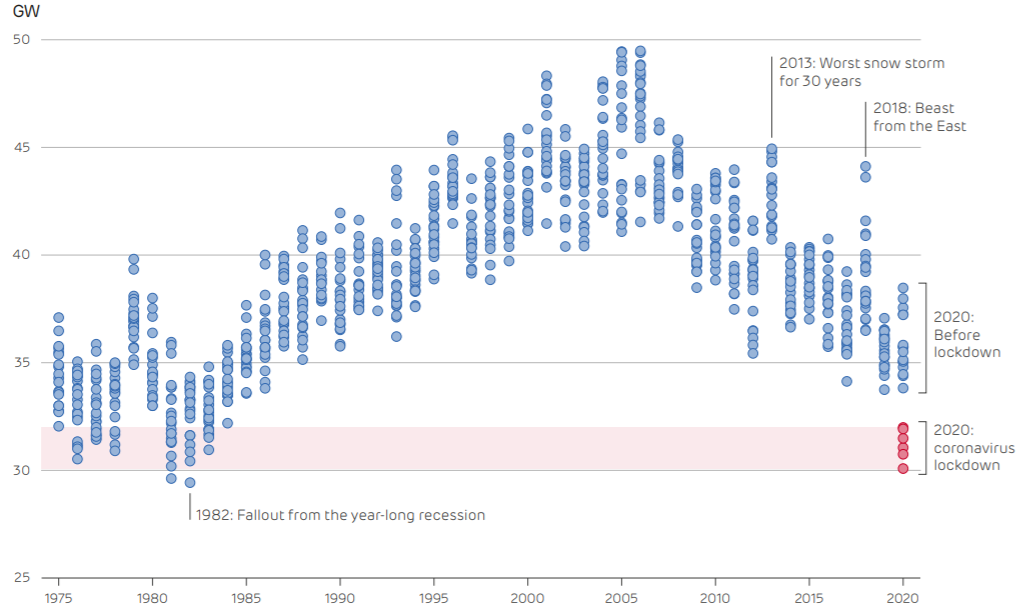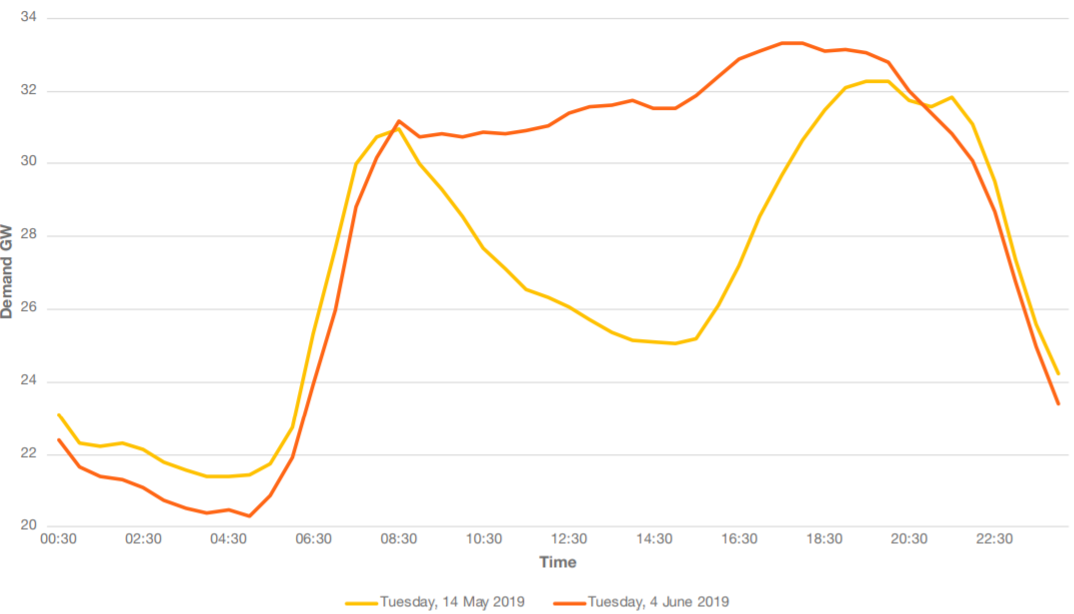Britain paying generators to switch off?
Since February 2020, electricity demand from the grid in Great Britain (GB) has seen a significant decrease following the introduction of social distancing measures and then a full lockdown in response to the coronavirus pandemic[i].
The average demand decrease for a weekday in March was about 13 per cent, while weekends were 11 per cent lower than the new weekday amount[ii]. Figure 1 below, from the Drax Electric Insights Quarterly – Q1 2020 report, shows how demand during March 2020 compares with the average daily electricity demand over past decades.

Figure 1: Daily average electricity demand in Great Britain across all working days in March 2020[iii]
Figure 1 shows demand now is at similar levels to the early 1980s and is likely to drop even further as the region heads into summer[iv].
Holiday periods and warmer weather have already contributed to reductions in demand from the grid of up to 20 per cent[v]. Changes to the daily demand profile have also been observed with reduced morning peaks and greater volatility[vi].
Demand from the grid will also be impacted by increasing solar energy generation as summer approaches. Figure 2, from the National Grid ESO’s Summer Outlook, shows the impact that embedded solar generation has on reducing the daytime demand from the transmission network. The two days compared in Figure 2 share similar temperature and embedded wind properties and were both Tuesdays, yet in June, there was 7.5GW of embedded solar generation on the grid[vii].

Figure 2: Impact of embedded solar generation on transmission system demand in summer 2019[viii]
These demand trends, from coronavirus impacts and seasonal changes, are also coinciding with lower wholesale energy prices[ix] and a longer-term plan to decarbonise the national grid[x]. Under these conditions, coal power stations have not run for more than 1000 continuous hours, a new record[xi]. This trend may see the remaining three coal power stations in GB exit the market earlier than expected.
In addition to coal, there have also been significant impacts on nuclear energy. Since early May 2020, the National Grid Electricity System Operator (ESO) has contracted with the owners of the Sizewell B nuclear power plant to reduce output for four months[xii] in order to manage the electricity network. This contract is worth more than £50 million and was required to prevent blackouts[xiii] from supply and demand imbalances.
Unlike coal and nuclear energy, renewable energy sources are likely providing better investor returns and have high levels of penetration this year[xiv]. However, the intermittent nature of renewables combined with the lower and less predictable demand is challenging the National Grid ESO’s ability to manage supply, demand and system security[xv].
Fortunately, the National Grid ESO has a number of tools available to gain flexibility in the system in supply and demand. These tools include:
- increasing demand on the grid by requesting pumped storage units to pump;
- using the balancing mechanism or direct trade to curtail flexible wind farm output;
- reducing interconnector energy imports through trades;
- issuing a local or national negative reserve active power margin (NRAPM), allowing the National Grid ESO to request additional plant flexibility[xvi];
- creating a new, temporary marketplace for smaller generators – known as the optional downward flexibility management (ODFM) product – that is a voluntary service to allow small-scale renewable generators to receive payments for following directions from the National Grid ESO to turn their generation down or off[xvii] (since implementation in May this has already been used to provide demand flexibility in the system[xviii]); and
- working with industry to modify the grid code to allow embedded generators to reduce their output in emergency situations to maintain the supply of electricity[xix].
Some of these tools have been introduced recently and are temporary to balance an oversupplied system[xx] and have kept the lights on to date. However, situations with high renewable energy resources and flexible demand are part of future operational planning and in the National Grid ESO’s roadmap to 2025. These conditions are likely to be providing an early test of this roadmap, which sets out how the sector’s transition will be managed safely and efficiently, providing benefits to consumers.
GB is by no means over the challenges of the pandemic, and the likely cost of balancing demand to September 2020 is estimated to be up to £826.3m, almost £500m more than the same four-month period in 2019[xxi].
Energy Networks Australia works closely with the Energy Networks Association in the United Kingdom (UK) and will continue to share insights from the response to the coronavirus pandemic and knowledge on responding to minimum demand challenges.
[i] Staffell, I., Green, R., Gross, R., Green, T., & Clark, L. (2020). Drax Electric Insights Quarterly – Q1 2020. Retrieved from drax.com/wp-content/uploads/2020/05/200515_Drax_20Q1_A2.pdf
[ii] Staffell, I., Green, R., Gross, R., Green, T., & Clark, L. (2020). Drax Electric Insights Quarterly – Q1 2020. Retrieved from drax.com/wp-content/uploads/2020/05/200515_Drax_20Q1_A2.pdf
[iii] Staffell, I., Green, R., Gross, R., Green, T., & Clark, L. (2020). Drax Electric Insights Quarterly – Q1 2020. Retrieved from drax.com/wp-content/uploads/2020/05/200515_Drax_20Q1_A2.pdf
[iv] National Grid ESO. (2020, April). Summer Outlook. Retrieved from nationalgrideso.com/document/167541/download
[v] Clowes, E. (2020, May 11). Low power usage good for renewables, bad for customers. Retrieved from digitaleditions.telegraph.co.uk/data/234/reader/reader.html?#!preferred/0/package/234/pub/234/page/114/article/43903
[vi] Clowes, E. (2020, May 11). Low power usage good for renewables, bad for customers. Retrieved from digitaleditions.telegraph.co.uk/data/234/reader/reader.html?#!preferred/0/package/234/pub/234/page/114/article/43903
[vii] National Grid ESO. (2020, April). Summer Outlook. Retrieved from nationalgrideso.com/document/167541/download
[viii] National Grid ESO. (2020, April). Summer Outlook. Retrieved from nationalgrideso.com/document/167541/download
[ix] Olney, M. (2020, April 21). Energy Price Forecast 2020 – The impacts of Coronavirus. Retrieved from Dyball Associates Limited: dyballassociates.co.uk/energy-price-forecast-2020-the-impacts-of-coronavirus
[x] Vaughan, A. (2018, January 6). UK government spells out plan to shut down coal plants. Retrieved from The Guardian: theguardian.com/business/2018/jan/05/uk-coal-fired-power-plants-close-2025
[xi] National Grid ESO. (2020, May 22). Twitter. Retrieved from twitter.com/ng_eso/status/1263486119783497730?s=20
[xii] Clowes, E. (2020, May 11). Low power usage good for renewables, bad for customers. Retrieved from digitaleditions.telegraph.co.uk/data/234/reader/reader.html?#!preferred/0/package/234/pub/234/page/114/article/43903
[xiii] Clowes, E. (2020, May 11). Low power usage good for renewables, bad for customers. Retrieved from digitaleditions.telegraph.co.uk/data/234/reader/reader.html?#!preferred/0/package/234/pub/234/page/114/article/43903
[xiv] Staffell, I., Green, R., Gross, R., Green, T., & Clark, L. (2020). Drax Electric Insights Quarterly – Q1 2020. Retrieved from drax.com/wp-content/uploads/2020/05/200515_Drax_20Q1_A2.pdf
[xv] National Grid ESO. (2020, April). Summer Outlook. Retrieved from nationalgrideso.com/document/167541/download
[xvi] National Grid ESO. (2020, April). Summer Outlook. Retrieved from nationalgrideso.com/document/167541/download
[xvii] National Grid ESO. (2020, May 7). The actions we’re taking to manage reduced demand for electricity this summer. Retrieved from nationalgrideso.com/news/actions-were-taking-manage-reduced-demand-electricity-summer
[xviii] Edwardes-Evans, H. (2020, May 11). UK electricity demand close to record low Sunday: National Grid. Retrieved from S&P Global: spglobal.com/platts/en/market-insights/latest-news/electric-power/051120-uk-electricity-demand-close-to-record-low-sunday-national-grid
[xix] National Grid ESO. (2020, May 7). The actions we’re taking to manage reduced demand for electricity this summer. Retrieved from nationalgrideso.com/news/actions-were-taking-manage-reduced-demand-electricity-summer
[xx] Edwardes-Evans, H. (2020, May 26). UK’s downward flexibility costs ‘not sustainable’: battery storage trader. Retrieved from S&P Global: spglobal.com/platts/en/market-insights/latest-news/electric-power/052620-uks-downward-flexibility-costs-not-sustainable-battery-storage-trader
[xxi] Edwardes-Evans, H. (2020, May 26). UK’s downward flexibility costs ‘not sustainable’: battery storage trader. Retrieved from S&P Global: spglobal.com/platts/en/market-insights/latest-news/electric-power/052620-uks-downward-flexibility-costs-not-sustainable-battery-storage-trader
